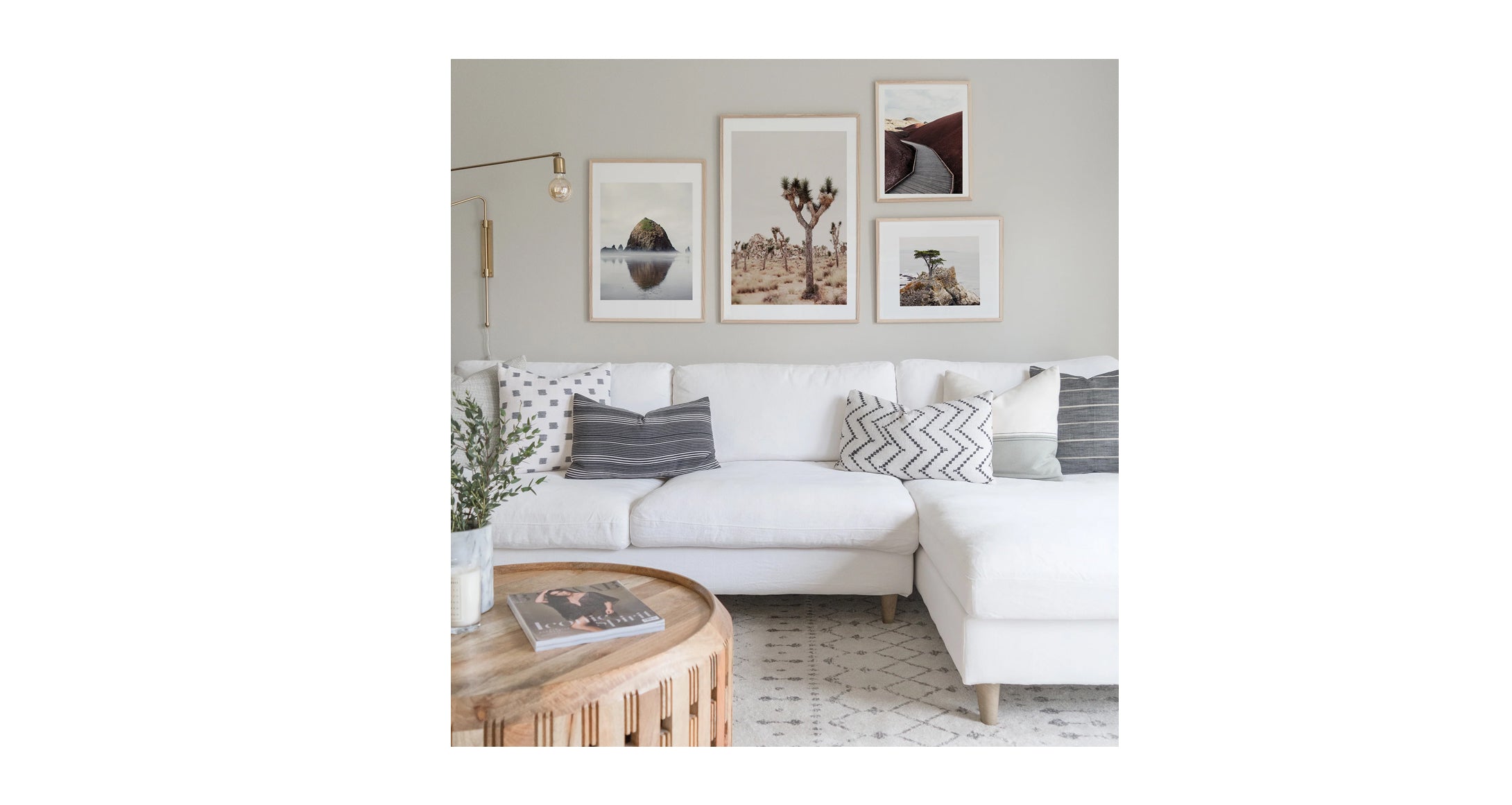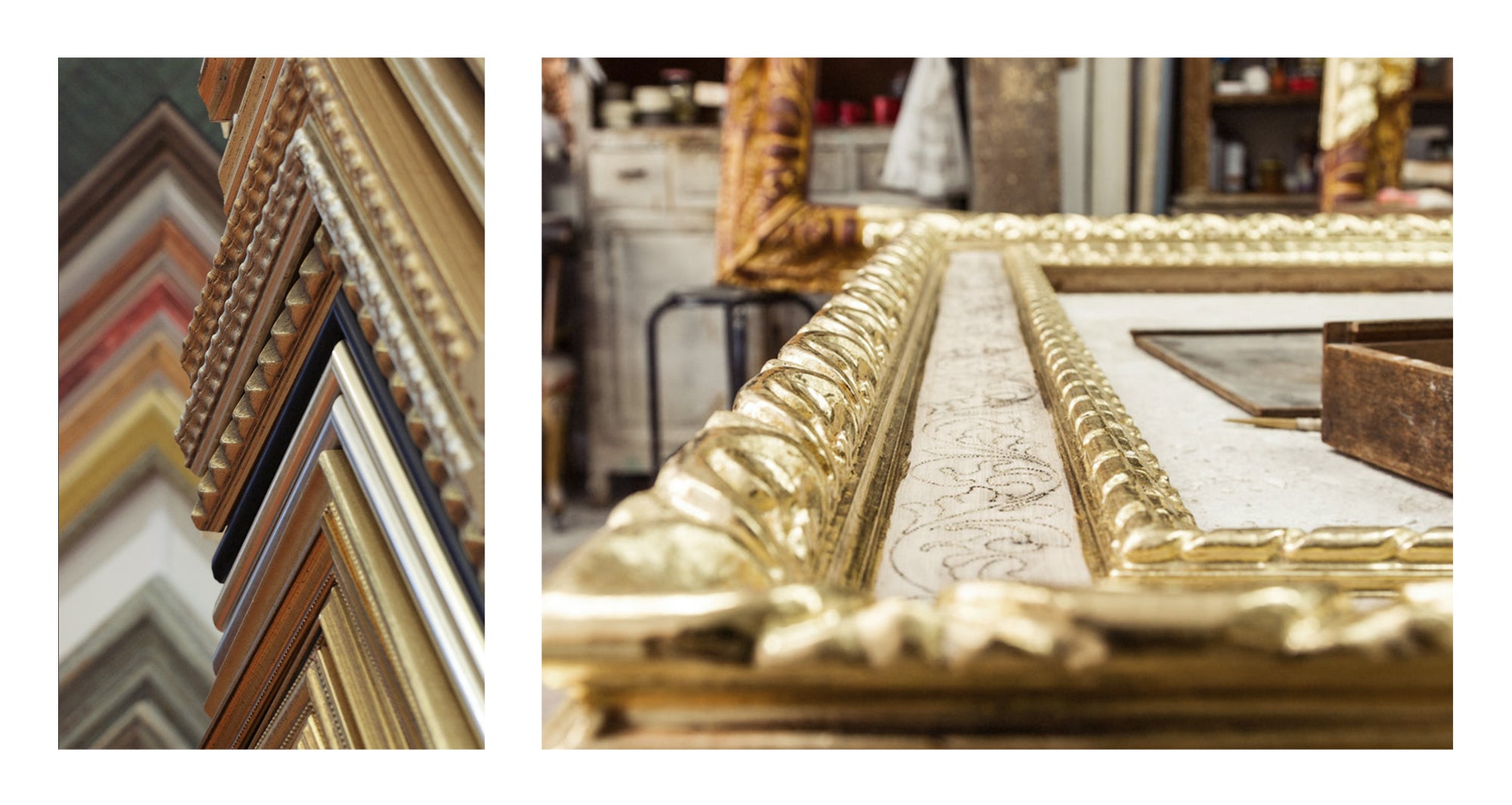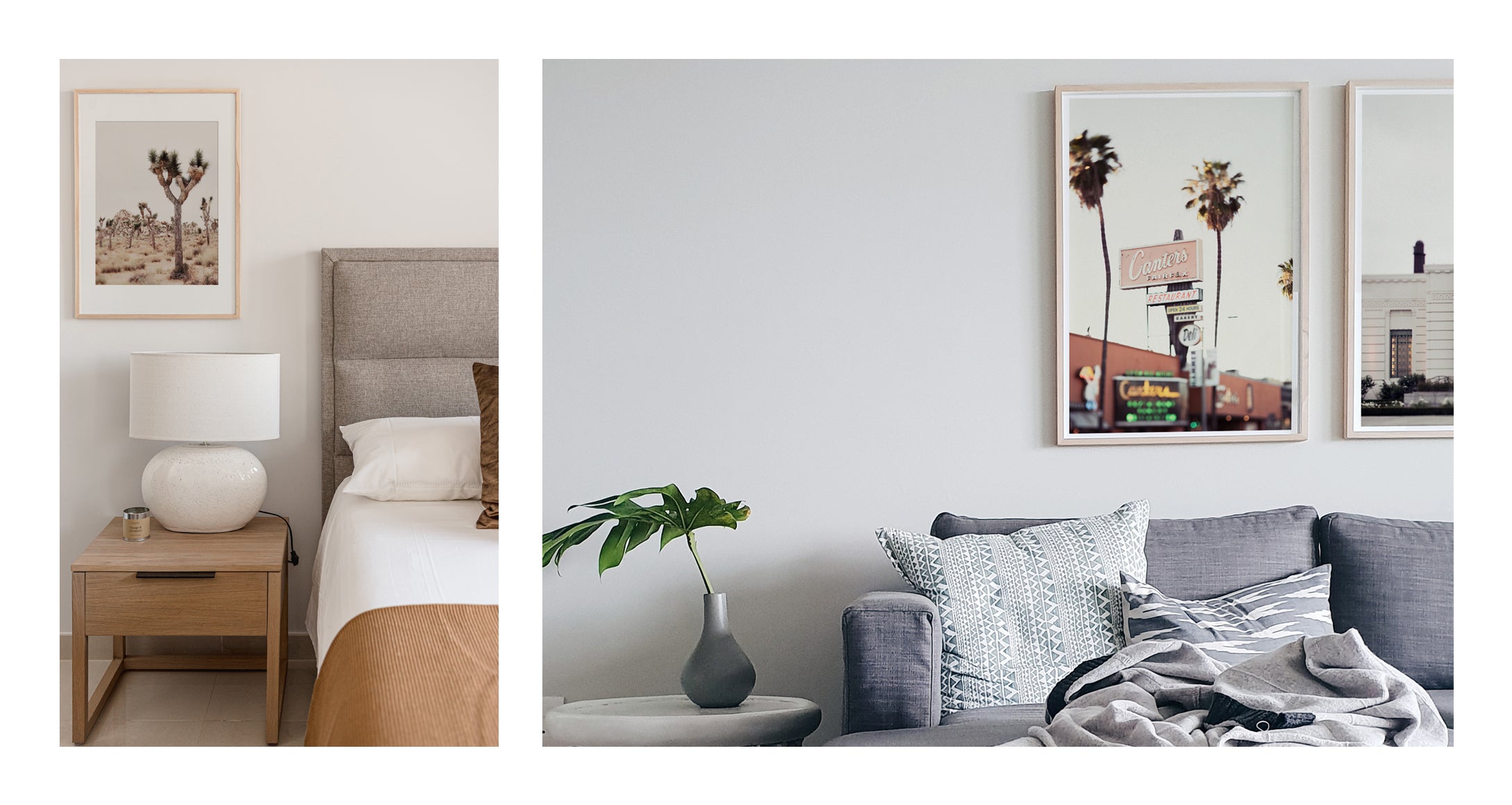
Art has the ability to reflect what's within an individual, and the frame serves as an invitation for the observer to enter into the artist's world. A frame that matches the artwork is more than just an accessory because it connects the piece, the space it occupies, and the viewer. The frame must never overshadow the artwork, but rather, they should complement each other by harmoniously blending their beauty.
Over time, framing techniques have changed, mirroring the development of artistic styles. From the ornate and elaborate frames of the Renaissance period to the simple and modern frames of contemporary galleries, framing has been an art form on its own. Today, we'll talk about how to use this tool with precision and grace, ensuring that your valuable pieces are presented in the best possible way.
 Framing and hanging art can sometimes feel overwhelming and complicated. Deciding on the right frame and mat combinations can be challenging, and putting holes in the walls can feel like a big commitment. As a result, many people procrastinate decorating their walls for weeks or even months.
Framing and hanging art can sometimes feel overwhelming and complicated. Deciding on the right frame and mat combinations can be challenging, and putting holes in the walls can feel like a big commitment. As a result, many people procrastinate decorating their walls for weeks or even months.
Framing my first artwork made me feel like I had grown up. When I first moved into my apartment, I found that custom framing was too expensive. I decided to look for frames at thrift stores and bought the rest from my local art supply store. This experience taught me to be resourceful and helped me bridge the gap between youthful spontaneity and mature refinement. If you're on a budget, framing your art can transform your space into a gallery-worthy showcase.
By following a few easy-to-follow steps, you can transform your space into a beautiful gallery without experiencing any stress.

The Role of a Frame in Art Presentation
Think of the frame as a storyteller, offering context to the tale of your art. It serves several functions, including:
- Providing a visual border that sets the artwork apart
- Protecting the piece from environmental damage
- Supporting the composition, be it through color contrast or harmony
- Guiding the viewer's eye toward focal points
Choosing the Right Frame
The frame is the framework of the story your art piece has to tell. It is a defining element that can either elevate or detract from the art it encases. Here's how to make that choice a true complement to the narrative within your art.
1. Factors to Consider when Selecting a Frame
When musing over which frame to choose, consider these key factors:
- Artwork Style: Is it better to match the frame with the artwork's style or create a contrast?
- Space it Occupies: Considering the artwork's surroundings is crucial when choosing a frame.
- Lighting Conditions: Excessive wall lighting can impact the reflectivity of the glass in the frame.
2. Different Frame Materials and Styles
The material of your frame can create vastly different aesthetics:
- Wood Frames: Exuding a warm and classic aesthetic, it can be stained or painted to match your preferences.
- Metal Frames: These can be sleek and discreet for a more modern, industrial feel.
- Ornate Frames: When the art calls for it, an ornate frame adds a touch of grandeur.
3. The Art of the Match
A good pairing of artwork and frame can enhance both. Here are some tips:
- Color Harmony: The right frame color can bring out subtle tones in the artwork.
- Conservation Frames: Sometimes less is more, especially when it comes to preserving historical or valuable art. Opt for a frame that’s gentle and understated, putting the focus squarely on the piece itself.
- Sizing: A frame's size should be in proportion to the piece. Too small and it's dwarfed. Too large and it overwhelms.

Art Framing Basics: Everything You Need to Know
1. Your house doesn't have to look like an art gallery
We all have awesome stuff we've collected over time - unique treasures discovered at flea markets, cherished heirlooms from family, photographs capturing unforgettable journeys, childhood drawings filled with nostalgia, and vintage posters that tell stories of the past.
Firstly, embrace the liberating freedom of choice when framing wall art. Allow yourself to explore various combinations, experimenting until you discover the ideal match that enhances the piece and harmonizes beautifully with your living space.
2. Protecting your art for the long term is essential
Proper protection helps maintain the integrity and condition of the artwork, preserving it for future generations to enjoy. Art that is well-protected retains its value over time, making it a worthwhile investment. Protecting art prevents damage such as fading, discoloration, or deterioration, ensuring that it remains visually appealing. Many form emotional connections to art pieces, and protecting them ensures these sentimental attachments are preserved.
- Choose acid-free materials
Acid-free materials are specifically designed to exclude acidic compounds that have the potential to degrade or harm artwork with the passage of time. These acidic substances are notorious for triggering yellowing, fading, and brittleness in various mediums like paper, photographs, and other artworks. By steering clear of acidic materials, artists and conservators can safeguard their creations from the detrimental effects caused by these compounds, ensuring the longevity and preservation of their work for generations to come.
- The Right Environment
Direct sunlight - With its ultraviolet (UV) rays, sunlight can fade the vibrant colors in paintings, prints, and photographs over time. This gradual process of deterioration not only impacts the visual appeal but also contributes to these artworks' warping, cracking, and discoloration. UV-protective glass helps safeguard your wall art from harmful UV rays, preserving its quality and appearance over time.
Humidity—Humidity can significantly affect art, particularly on delicate materials such as paper, canvas, wood, and certain types of paint. High humidity levels can cause paper to absorb moisture from the air, leading to warping, wrinkling, and buckling. This can distort the appearance of drawings, prints, and watercolor paintings. Conversely, low humidity levels can cause paper to become brittle and prone to cracking or tearing. Wooden frames and supports can also be affected by changes in humidity. High humidity can cause wood to swell and warp, potentially distorting the shape of frames and stretcher bars. Conversely, low humidity can cause wood to shrink and crack.
Techniques for Protecting Artwork from Damage- Cleaning Procedures: Regular, gentle cleaning prolongs your art’s shelf life.
- Inspection: Regularly check on your art, making sure its condition hasn't changed.
- Reframing: Sometimes, a piece outgrows its frame. Be willing to change the story if the characters demand it.
- Preventative Techniques: Sometimes, it’s not about fixing damage but avoiding it altogether
 why is matting art important
why is matting art important
1. Does art need to be matted?
An art mat, also known as a mat-board or simply a mat, is a thin and flat material made from board or paper. It usually has a rectangular or square opening in the center. Art mats act as a border or buffer between the artwork and the frame. They enhance the artwork's presentation and protect it from direct contact with the glass.
2. Do pictures look better with matting?
When deciding whether to mat an artwork, personal preference, the style of the piece, and the overall aesthetic should be considered. Here are some factors to help make that decision.
- Enhancement: Matting can enhance artwork by creating a visual border and sense of depth in the frame, drawing attention and adding a professional appearance.
- Protection: Mats act as a barrier between artwork and glass, preventing damage from moisture buildup, sticking, and contaminants. This extra protection is particularly beneficial for delicate or valuable pieces.
- Aesthetic: When choosing how to display your artwork, it's essential to think about the style and mood of the piece and the decor of the room in which it will be displayed. One way to enhance the overall aesthetic is by using mats to complement or contrast with the colors in the artwork and frame. This can add visual interest and make your artwork stand out even more.
- Space: Mats are used in framing to create visual space within the frame. They help balance the composition and bring attention to specific elements of the artwork. They can also be used to adjust the size of the artwork to fit a standard frame or to create a custom look.

3. What color mat to use for art?
Choosing the right mat color is crucial when framing artwork. Consider factors such as complementing or contrasting the colors in the artwork, matching the mat color to the style and theme of the artwork, and reflecting your personal taste and preference. Experiment with different combinations to find the perfect match for your artwork and frame.
4. When should you use float matting?
Float matting is a technique where the artwork is mounted on top of the mat, creating a stunning "floating" effect within the frame. It's an excellent choice for contemporary artwork, three-dimensional or textured pieces, large-scale artwork, or any artwork that requires a unique presentation style. Float matting adds sophistication and visual interest to the framing design, allowing the artwork to shine and take center stage within the frame.
5. Techniques for Proper Mounting and Securing Artwork
When it comes to mounting, meticulousness is king:
- Hinging: Using photo corners or archival tape to hinge the artwork to the backboard.
- The Adhesive Issue: Only employ adhesives that are acid-free and reversible to avoid damage to your art.

Custom Framing vs. DIY Framing
The age-old question - go pro with a framer or DIY it? Both have their perks, so let's break down when to lean one way.
1. Custom Framing Services
Custom framers bring expertise and a vast array of materials to the table but come at a premium price.
2. Tips for DIY Framing Projects
For the brave DIY-er, here are some pro tips to achieve a polished result:
- Invest in Quality Tools and Materials: This is not the time for penny-saving. The integrity of your art depends on it.
- Take it Slow: Rushed framing jobs are the leading cause of errors and, worse still, damaged art.
- Precision Matters: Measure and remeasure. Cut and recut. Art does not take kindly to untidy craftsmanship.
3. Professional Framing: The When and Why
Not every art piece requires the services of a professional, but there are tell-tale moments when it’s worth considering:
- Rare, Historical, or High-Value Artwork: The risk is invariably higher with these pieces, and the precision of professional framing is often warranted.
- Unusual or Large-Scale Pieces: Unconventional pieces often require unconventional solutions. A framer's expertise might be irreplaceable.

A Step-by-Step Guide to the Framing Process
- Measure Twice: Or three, or four times — make sure your sizing is spot on.
- Prepare: Clean your glass, choose your mounting style, and ensure your materials are free of any contaminants.
- The Assembly: Carefully mount your artwork, secure it in the chosen frame with appropriate spacers if necessary, and seal the back of the frame to avoid dust and bugs.
Essential Tools for Framing:
hanging Materials: Wire and hooks to properly hang your masterpiece
frame (including glass)

 3. Secure your art print: To secure your print to the mat, tape the back of the print using acid-free tape. First, place the print face-down along the back of the mat. Then, use several strips of tape to secure it in place. You can add more strips of tape along the back edge of your print as needed. Remember, using acid-free tape will ensure that your print won't be damaged in the long run.
3. Secure your art print: To secure your print to the mat, tape the back of the print using acid-free tape. First, place the print face-down along the back of the mat. Then, use several strips of tape to secure it in place. You can add more strips of tape along the back edge of your print as needed. Remember, using acid-free tape will ensure that your print won't be damaged in the long run.
 4. Handle with care: In order to finish the task, be sure to handle the print with care as you place it into the frame, being cautious not to leave any fingerprints. Afterward, insert push pins into the backing board to secure it in position.
4. Handle with care: In order to finish the task, be sure to handle the print with care as you place it into the frame, being cautious not to leave any fingerprints. Afterward, insert push pins into the backing board to secure it in position.

Displaying and Hanging Art
Once framed, your art needs a stage. How and where you hang it can either complete the performance or leave it feeling disjointed.

1. Finding the Right Spot
Art is not just art; it is part of the room’s narrative. Here’s how to find that perfect backdrop:
- The Art of Lighting: Tailor your lighting to the piece. Consider natural vs. artificial light, and how it plays off the artwork's surface and frame.
- Visual Balance: Whether in a solo exhibition or amongst other pieces, the balance of the room is as critical as the art itself.
2. Tips for Hanging Securely and Evenly
Nothing mars a wall like a wrongly hung piece of art. Some tricks of the trade:
- Use a Level: Seems simple, but it's the make or break for straight art.
- The Two-Point Hang: For larger pieces, two hanging points offer superior stability.
3. Creative Display Possibilities
A gallery wall is all the rage but is but one of myriad creative ways to exhibit your framed art:
- Layer Art: Stack frames on shelves for a dynamic, casual display.
- The Statement Single: Sometimes, one huge piece is all you need.
To discover the perfect art size, check out our latest blog post.

Framing art isn't just for galleries and museums; it's something every art enthusiast, decorator, and creator can and should get the hang of. When done right, it turns the ordinary into something extraordinary. More than safeguarding your investment or sprucing up your space; it's about respecting the art and the artist's vision. Within the canvas and frame is a piece of their soul shared with you. It's a bond, a duty, and ultimately, a chance to add joy and depth to your surroundings. Skillful framing transcends mere art appreciation; it's a celebration, a tribute to a life of vibrancy. In these small, intricate, and heartfelt touches, a community of art enthusiasts nurtures a world where beauty feels at home.
where to buy frames


5. west elm - frame size 8"x10" / prints size 5"x7" 6. crate and barrel - frame size 15"x15" / print size 8"x10" 7. amazon - frame size 11"x14 / print size 11x"x14" 8. pottery barn - frame size 16x20 / print size 11x14
If you're feeling overwhelmed by the options, remember that simplicity is often the key. A minimalist black frame can provide timeless elegance, allowing the artwork to take center stage. Alternatively, a natural wood frame can add warmth and texture, creating a cozy atmosphere. You can transform your space into a work of art with patience and creativity
With Love!












